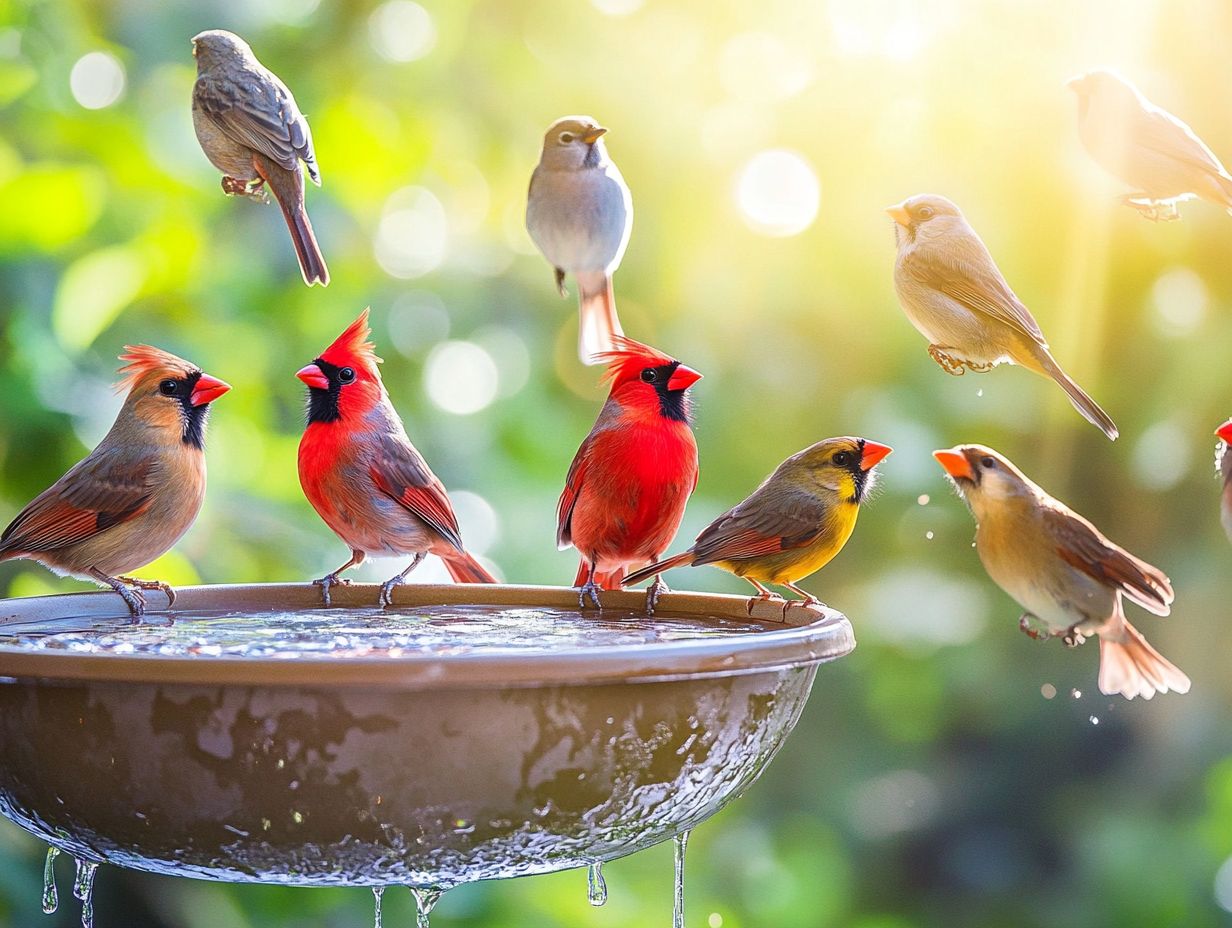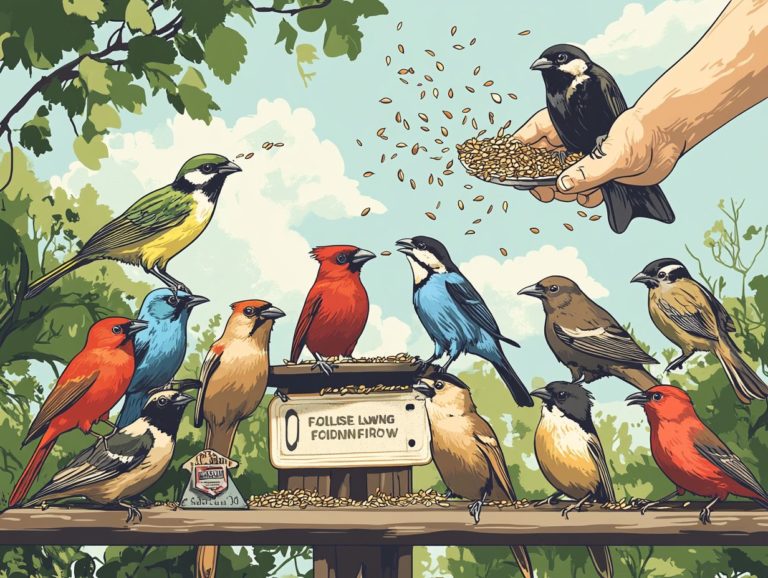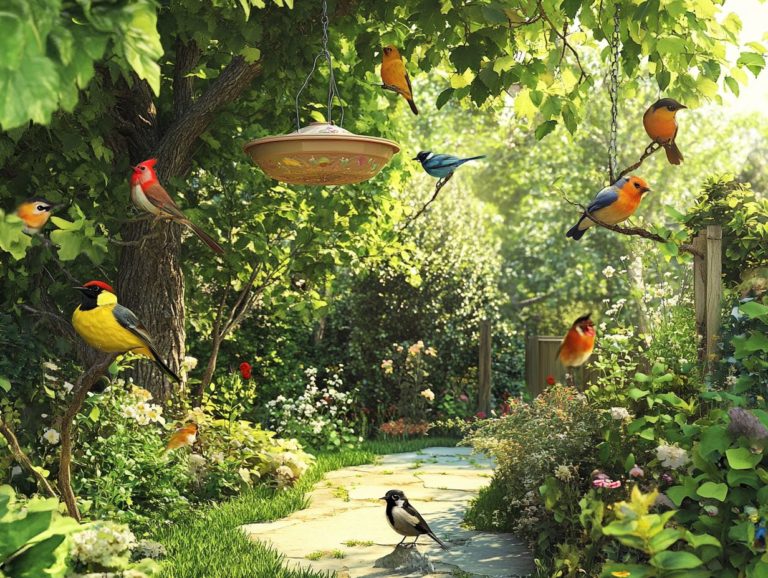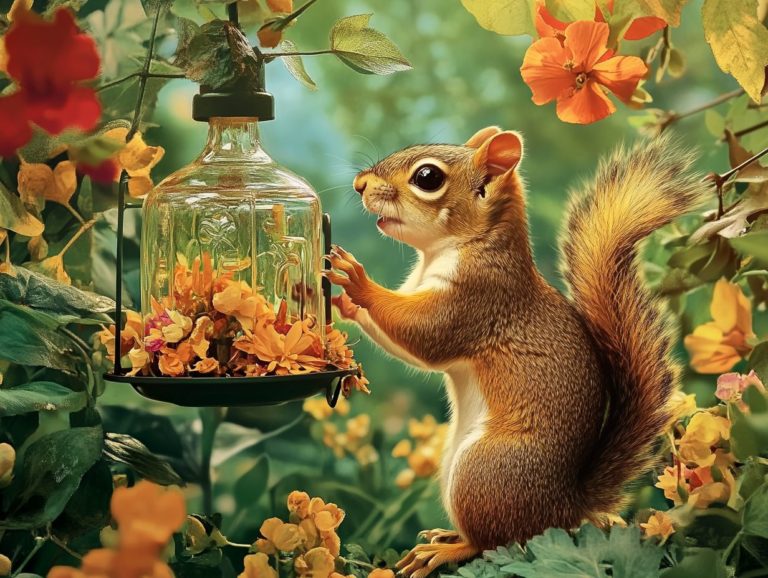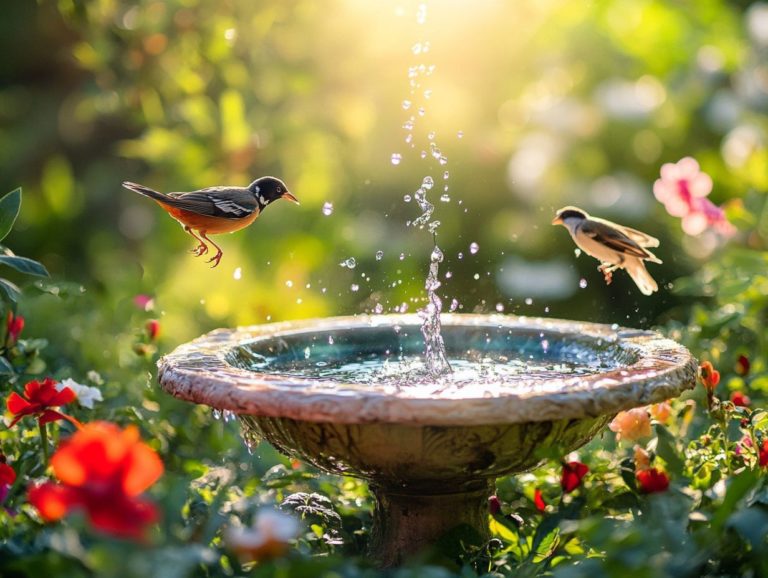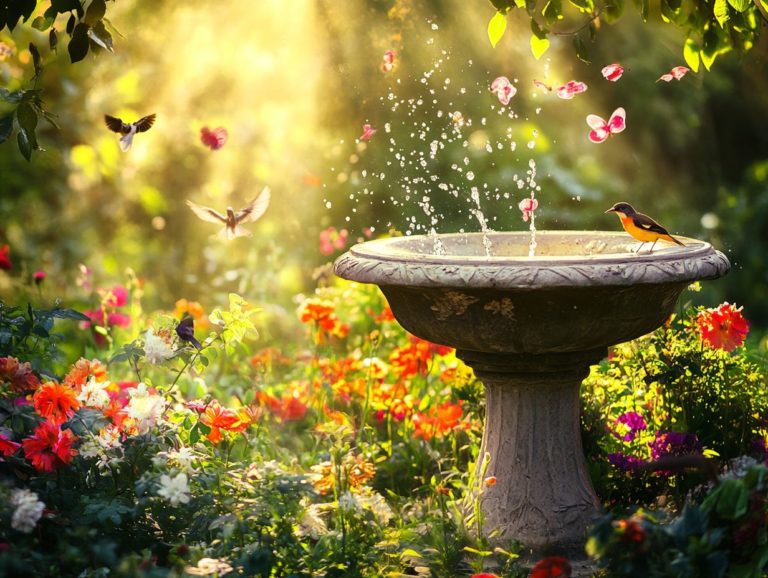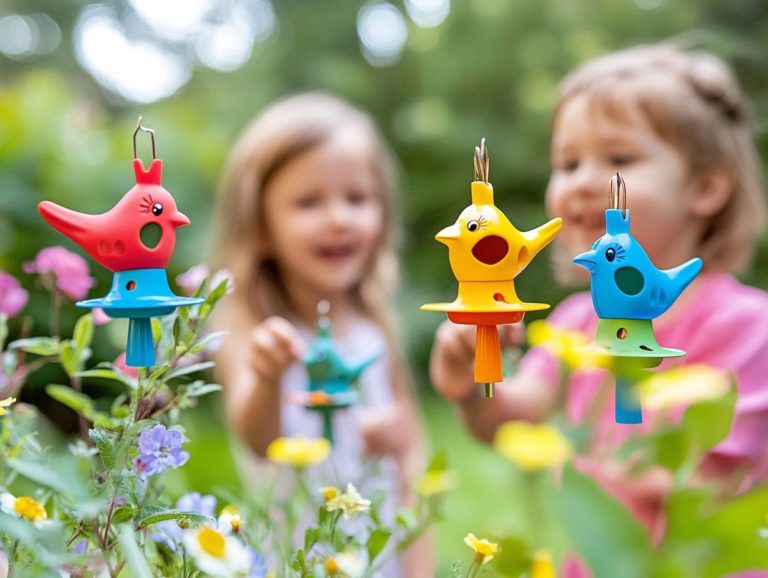The Importance of Water in Bird Feeding Stations
Bird feeding stations can transform your garden into a delightful haven, drawing in a wonderful array of feathered friends. Water is essential in elevating these spaces, quenching their thirst while promoting a vibrant ecosystem.
You can incorporate various types of water sources and discover tips for maintaining cleanliness. Learn how to attract different bird species with the right features. Dive into the art of creating a flourishing avian oasis right in your own backyard!
Contents
- Key Takeaways:
- The Role of Water in Bird Feeding Stations
- Types of Water Sources for Bird Feeding Stations
- How to Maintain and Clean Water Sources
- Attracting Birds with Water: The Importance of Water Needs
- Frequently Asked Questions
- Why is water important in bird feeding stations?
- Do birds need water in addition to the food provided in feeding stations?
- How often should water be changed in bird feeding stations?
- Can bird baths or fountains be used in bird feeding stations?
- What are the consequences of not having water in a bird feeding station?
- Are there any other benefits to having water in bird feeding stations?
Key Takeaways:
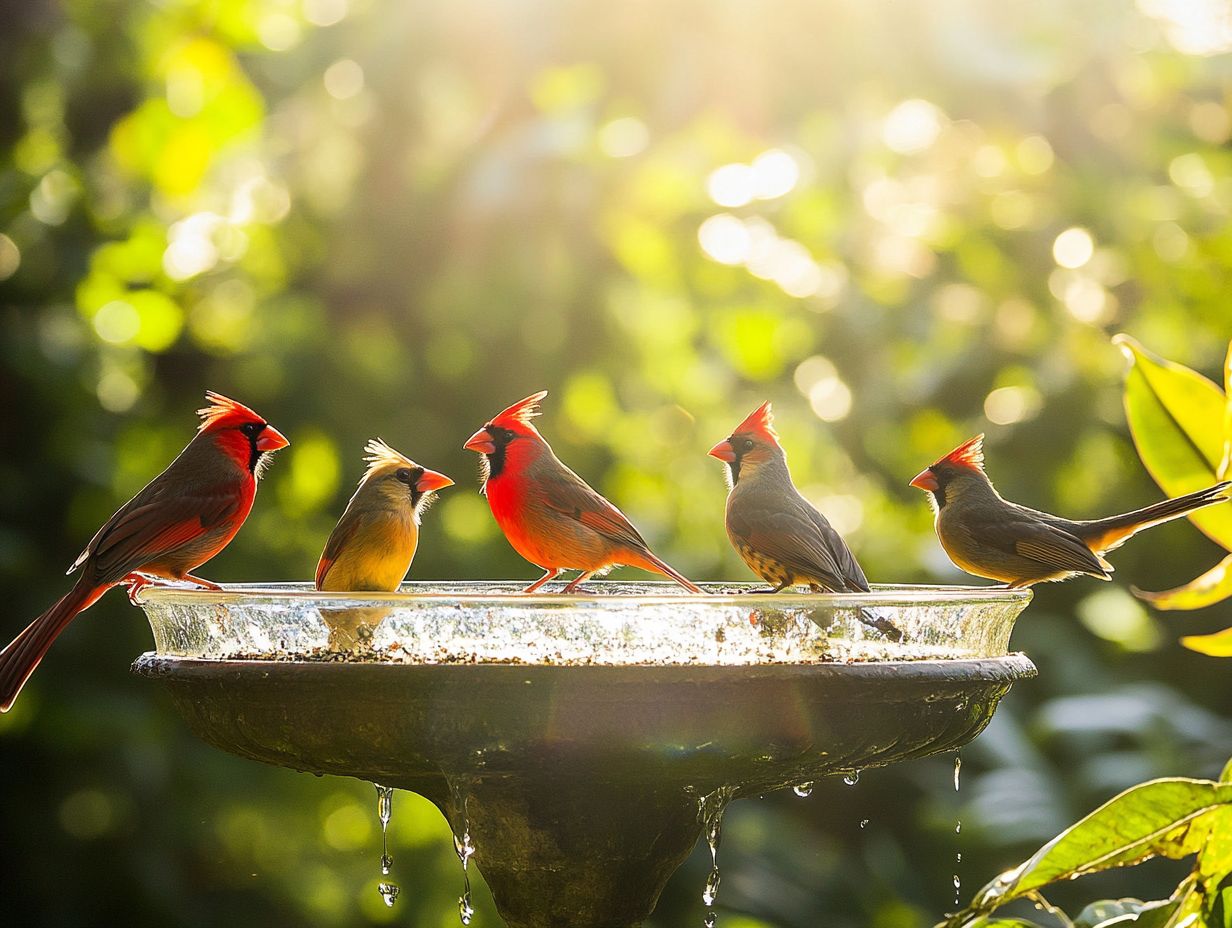
- Water is crucial for bird feeding stations, serving as hydration and helping maintain healthy feathers.
- Different water sources like birdbaths and misters can attract various bird species.
- Keep water sources clean to protect visiting birds.
What are Bird Feeding Stations?
Bird feeding stations are your ticket to transforming outdoor spaces like gardens or backyards into vibrant havens for various bird species. These fun spaces provide essential resources such as food, water, and shelter.
Stock your bird feeders with seeds and nuts. Incorporate bird baths for hydration, and if you re feeling generous, add some nectar for those charming hummingbirds. You create a thriving bird habitat that actively supports local wildlife.
By offering a range of seeds think sunflower and safflower you can cater to the diverse preferences and dietary needs of your feathered visitors. Water sources are just as vital; they not only quench thirst but also provide crucial bathing spots for birds.
Placement matters too. Positioning these feeding stations in safe, sheltered areas encourages shyer species to drop by, cultivating a welcoming atmosphere where birds feel secure. Surrounding the feeding station with native plants adds natural beauty and creates a mini-ecosystem that attracts birds while offering safe roosting and nesting spots.
The Role of Water in Bird Feeding Stations
Water is essential for your bird feeding stations. It acts not just as a refreshing drink for thirsty visitors but also creates a safe place for birds to thrive in your backyard habitat.
Providing clean water effectively caters to the hydration needs of various bird species, especially during those sweltering summer months when natural water sources can become scarce.
Why is Water Important for Birds?
Water serves not only to quench their thirst but also plays a critical role in their overall health and well-being. Access to reliable water is fundamental for feather maintenance, digestion, and temperature regulation.
During sweltering summer months, birds need ample hydration to combat the heat and stay active. In colder seasons, water sources may freeze, making it imperative for birds to seek alternative hydration methods, like melting snow or finding unfrozen ponds.
Sufficient hydration supports key biological functions, including nutrient absorption and waste elimination. This ensures that birds remain strong and resilient throughout seasonal changes. Whether it’s spring’s vibrant breeding season or the migratory challenges of autumn, water availability directly impacts their health, reproductive success, and overall survival.
Don t wait! Start creating your bird feeding station today and make sure your feathered friends have access to water!
Benefits of Providing Water in Bird Feeding Stations
Providing water in your bird feeding stations unlocks a wealth of benefits. It attracts a diverse array of bird species, promotes healthy birds, and enriches the overall ecosystem of your backyard habitat. Clean water sources quench birds’ thirst and offer a safe haven for bathing and socializing.
Get ready to enjoy a colorful cast of feathered visitors flocking to your yard, from vibrant songbirds to striking waterfowl. Bathing is essential; it helps birds maintain their feathers and plays a crucial role in their health, preventing skin parasites and ensuring their feathers are in top shape for flight.
A steady supply of clean water supports vital processes like feeding and breeding, enhancing biodiversity. This surge in avian activity creates a flourishing environment, encouraging various insects and plants to thrive, thereby bolstering your habitat’s resilience and ecological balance.
Types of Water Sources for Bird Feeding Stations
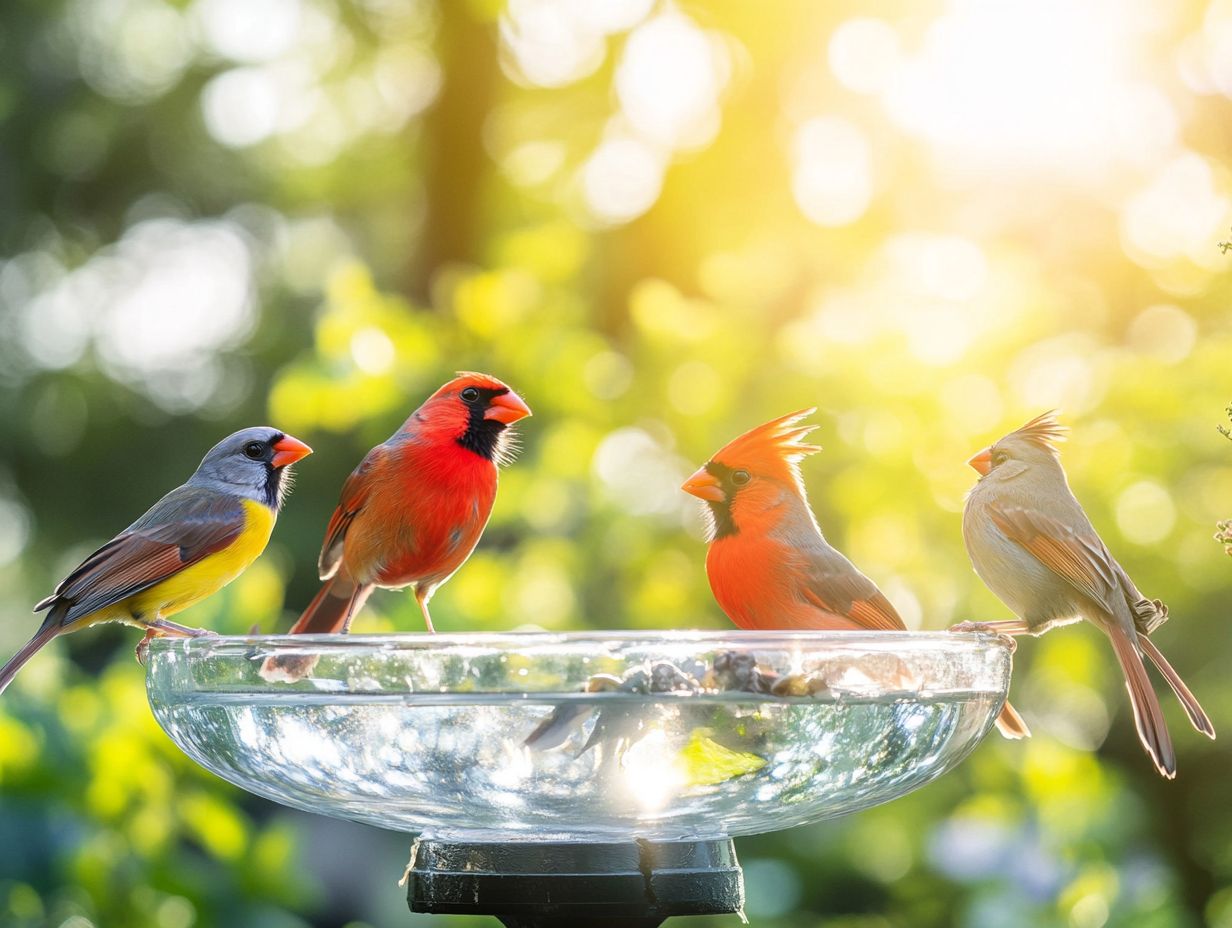
You have a variety of water sources for your bird feeding stations, each catering to the unique needs of different bird species.
Consider incorporating bird baths, which create a delightful space for birds to drink and bathe. You can also use water dishes, strategically placed around your yard, to attract feathered visitors.
Misters or drippers provide a gentle water source that many backyard birds find irresistible.
Birdbaths
Birdbaths serve as a popular and effective water source for birds. They offer a place to drink and a vital opportunity for bathing, essential for maintaining feather cleanliness and health. By strategically placing a birdbath in your yard, you can attract a delightful variety of backyard birds, especially during the summer months when clean water becomes a coveted resource.
These charming outdoor features come in various designs and materials, from elegant stone structures to simple ceramic models, allowing you to select one that perfectly complements your garden s aesthetics.
For optimal visibility and enjoyment, position the birdbath in a quiet, sunny location, ideally near shrubs or trees that provide natural cover for your feathered visitors.
Regular maintenance is key. Change the water frequently and clean the basin weekly to prevent algae growth and keep the area hygienic. This attentive care promotes the well-being of the birds and enhances your garden s allure, creating a vibrant ecosystem that attracts a diverse array of avian life.
Water Dishes
Water dishes offer a simple yet highly effective way to provide clean hydration for backyard birds. By placing these shallow and accessible sources of water around your yard, you create multiple hydration points for various bird species, each of which may favor different locations.
These water dishes enhance the visual charm of your outdoor space and demand minimal maintenance, making them an exceptionally practical choice for any bird enthusiast. When selecting the right dishes, opt for materials that are both durable and easy to clean ceramic or plastic are excellent options for effortless rinsing and sanitation.
Keep these dishes consistently filled with fresh water to attract birds and promote their health. Positioning them in shaded areas helps maintain cooler water temperatures. Adding pebbles or stones can provide safe footing for smaller birds, increasing the likelihood of a diverse range of species visiting your yard.
Misters and Drippers
Misters and drippers are innovative water features that offer a continuous hydration source for birds, especially in hot climates where traditional water sources evaporate quickly.
These systems create a gentle mist or dripping effect, drawing in birds while also maintaining a cooler environment around them.
The beauty of these specialized systems lies in their ability to deliver water efficiently, avoiding the usual splashing you d find with conventional bird baths. Installing misters and drippers is usually a breeze. With just some basic tools and a nearby water source, they are accessible for any backyard enthusiast.
When you set up these features, it s essential to think about placement. Positioning both the mister and dripper in shaded areas will enhance their effectiveness. Regular maintenance is crucial, too. Cleaning the nozzles to prevent clogs and checking for leaks will ensure that these systems run smoothly, providing a consistent and refreshing water supply for your feathered visitors.
How to Maintain and Clean Water Sources
Maintaining and cleaning the water sources in your bird feeding stations is crucial for creating a safe haven for our feathered friends and promoting their well-being.
By regularly monitoring the cleanliness of the water, you can effectively prevent the spread of diseases and ensure that birds have access to fresh, clean hydration for both drinking and bathing.
Cleaning the water not only keeps birds healthy but makes your garden a lively paradise!
Tips for Keeping Water Clean and Safe for Birds
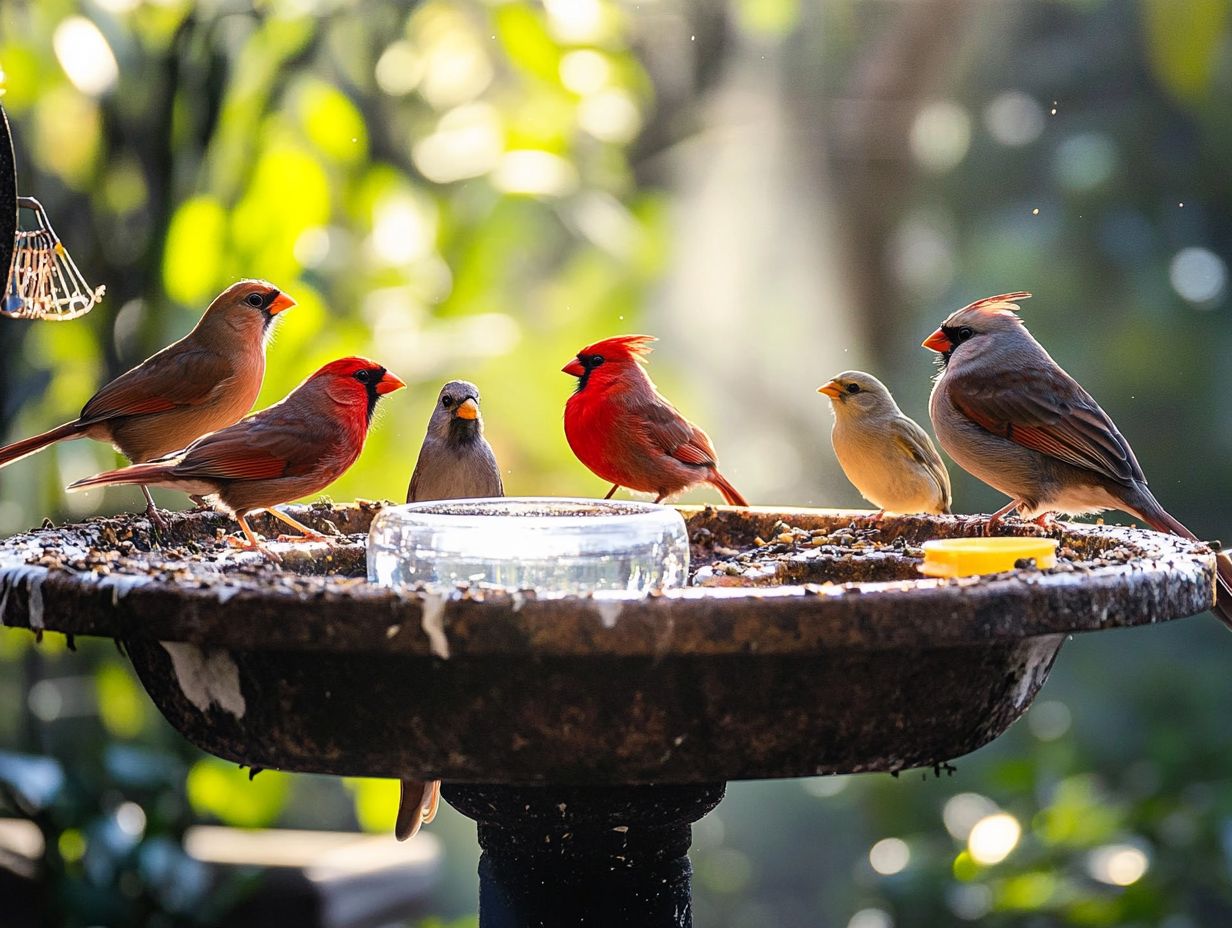
- Establish a regular cleaning schedule and monitor water levels to avoid stagnant water.
- Clean bird baths and water sources at least once a week. Use a mild detergent and a stiff brush to effectively remove algae and other buildup.
- Opt for solutions specifically designed for cleaning bird baths, as they are non-toxic and safe for your avian friends.
- Investing in a bird waterer can help ensure a consistent supply of fresh water.
- Add a small amount of white vinegar as a natural disinfectant.
- To combat algae growth, consider adding rocks or pebbles to enhance water movement and position the baths in shaded areas to reduce direct sunlight.
- In cold weather, keep water sources accessible to birds to prevent them from freezing.
Regular maintenance ensures not only that birds visit safely but also that they thrive in your garden.
Attracting Birds with Water: The Importance of Water Needs
Utilizing water features with intention can greatly elevate your capacity to attract birds to your birdscaped backyard, transforming it into a welcoming habitat that provides vital resources such as food, shelter, and fresh water.
By thoughtfully integrating different water sources into your bird feeding stations, you can entice a diverse array of bird species, enriching your outdoor experience and bringing a symphony of nature right to your doorstep. Ensuring good water quality is key to attracting these feathered friends.
Attract More Birds with Water!
To attract a variety of bird species, it s crucial to understand their different likes for water sources. Some birds may prefer shallow water for drinking. Others may be drawn to deeper baths for a refreshing dip. It s essential to provide an array of options to cater to their needs.
For example, finches and sparrows will likely flock to a simple, shallow dish filled with fresh water. Larger birds like crows and jays might favor a deeper feature, such as a birdbath. Adding moving water, like a fountain or a small stream, can further entice them, mimicking their natural habitat. By combining food sources, such as seeds or suet (a type of fat that birds eat), with these water features, you significantly enhance the allure of the environment.
Make sure the areas around the water sources are green and safe. This helps attract more birds. The Georgia Audubon Society often emphasizes the importance of providing water to support this environment.
Frequently Asked Questions
Why is water important in bird feeding stations?
Water is important in bird feeding stations because it provides birds with a source of hydration and helps them maintain their feathers, which are needed for flying and staying warm. By recognizing their water needs, you can create a more inviting habitat.
Do birds need water in addition to the food provided in feeding stations?
Yes, birds need water in addition to the food provided in feeding stations. Water is essential for their overall health and well-being, and birds cannot survive on food alone. This necessity highlights the need to provide water consistently in your setup.
How often should water be changed in bird feeding stations?
Water should be changed in bird feeding stations at least once a day to prevent the growth of harmful bacteria and to keep the water fresh and clean for the birds. Regularly monitor water levels to ensure they remain optimal.
Can bird baths or fountains be used in bird feeding stations?
Yes, bird baths or fountains can be used in bird feeding stations. They provide a natural and inviting source of water for birds and can also attract a wider variety of bird species, making them a valuable addition to any bird watching setup.
What are the consequences of not having water in a bird feeding station?
Not having water in a bird feeding station can lead to dehydration and poor health in birds. It can also discourage birds from visiting the feeding station, reducing the overall enjoyment of bird watching. As such, it is essential to maintain a reliable water source, especially during cold weather.
Are there any other benefits to having water in bird feeding stations?
Yes, there are other benefits to having water in bird feeding stations. It can attract a wider range of bird species, provide a place for birds to bathe and groom, and create a peaceful and relaxing atmosphere for bird watching. Joining initiatives like the Audubon Sanctuary Tour can also help you learn more about enhancing your setup.
Don’t wait! Start transforming your space into a bird-friendly haven today!

